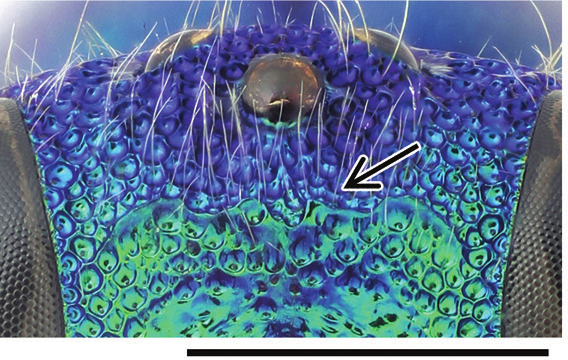Chrysis terminata
A relatively common species in forest margins and clearings with sun-exposed dead wood. The host is the Eumeninae Ancistrocerus nigricornis. The species can be separated from closely related species by the uniform coarse puncture of the tergites and the frontal carina that is separated into tooth-like tubercles.
- Innhold
- Diagnosis
- Distribution
- Biology
Diagnosis
Figure 153
Head, frontal view (arrow indicating frontal carina): C. terminata ♀. Scale 1 mm.
Figure 154
Head, dorsal view (arrow indicating frontal carina): C. terminata ♀. Scale 1 mm.
Length 6–10 mm.
The species resembles closely C. ignita by its colour, structure and habitus. However, the frontal carina has medially four tooth-like tubercles in both sexes (Figs 153, 154), the mesosoma is more homogeneously blue without extensive green areas on the pronotum and the mesoscutellum, and the body is slightly more elongate with more parallel sides.
Distribution
Latvia, Lithuania, Norway, Sweden. Relatively common (especially in south-eastern Sweden, Öland and Gotland).
West Palearctic: from western Europe to central Asia (Linsenmaier 1997).
Biology
Habitat: forest margins, clearings and gardens with sun-exposed dead wood, but also sparsely vegetated sandy areas.
Flight period: late April to early August. The flight begins earlier than in other species of the C. ignita group.
Host: Ancistrocerus nigricornis (Curtis) (Vespidae) (van Lith 1954, Linsenmaier 1959, our own obs.).


